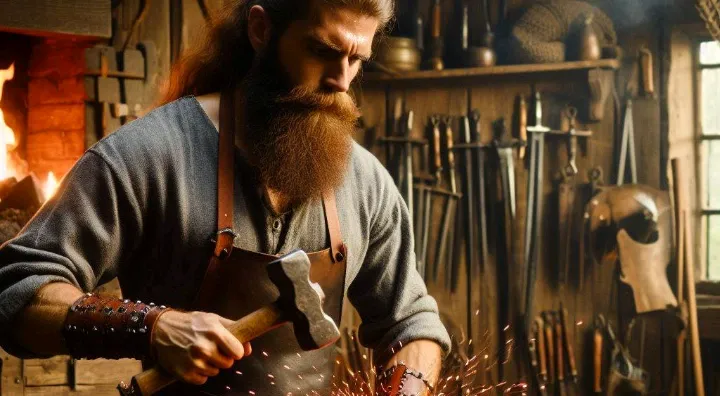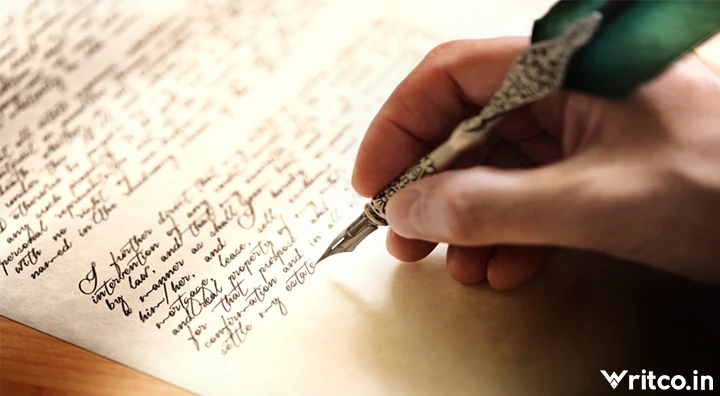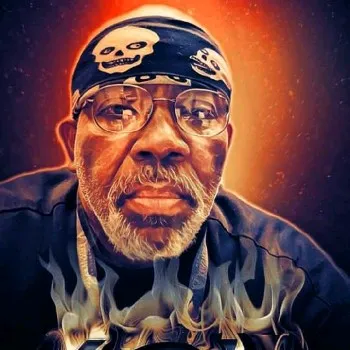La Fragua del Destino / The Forge of Destiny
La Fragua del Destino (Spanish version)
Corría el año 1342 en Aldeaverde, Reino de Aragón.
Elías, un joven huérfano de ojos vivaces y mirada penetrante, se encontraba junto al yunque. El aire vibraba con el ritmo del martillo contra el hierro al rojo vivo, creando una sinfonía de golpes metálicos que resonaba en las calles empedradas. La fragua, iluminada por el resplandor del fuego y el sudor de la frente de Elías, era su hogar, su refugio y su escuela.
Desde pequeño, Elías había sentido una conexión especial con el metal. Observaba fascinado como su maestro, el venerable herrero Baltazar, transformaba simples barras de hierro en herramientas indispensables para la vida diaria. El calor del fuego, la fuerza bruta del martillo y la destreza de las manos de Baltazar esculpían no solo el metal, sino también el destino de cada objeto forjado.
Un día, mientras observaba a Baltazar trabajar en una espada para el caballero más respetado de la región, Elías sintió una punzada de ambición. Ansiaba seguir los pasos de su maestro y convertirse en un herrero de renombre. Baltazar, percibiendo la llama en los ojos de su aprendiz, le ofreció la oportunidad de convertirse en su pupilo.
Los años que siguieron fueron una ardua prueba para Elías. La fragua se convirtió en su segundo hogar, donde aprendía los secretos del oficio con dedicación y tenacidad. Sus manos se curtieron con el calor del fuego y sus músculos se fortalecieron con el ritmo constante del martillo. A medida que dominaba las técnicas de forjado, Elías descubría también la importancia de la paciencia, la perseverancia y la humildad.
Sin embargo, el mayor desafío de Elías llegó cuando Baltazar enfermó gravemente. La responsabilidad de la fragua recayó sobre los hombros del joven aprendiz, quien aún no se sentía preparado para asumir el legado de su maestro. Su primer encargo oficial fue una espada para el mismo caballero a quien Baltazar había forjado su arma legendaria. La presión lo agobiaba, las dudas lo asaltaban y el miedo al fracaso lo consumía.
En un momento de desesperación, Elías arrojó la espada incompleta al fuego, observando con impotencia cómo las llamas la devoraban sin piedad. Se desplomó sobre el suelo, derrotado y convencido de su incapacidad. Pero al amanecer, un rayo de sol se coló por la ventana de la fragua, iluminando las brasas del fuego. Elías se acercó con recelo y vio algo que lo dejó atónito: en el centro de las cenizas, brillaba una pieza de metal puro, libre de imperfecciones, un acero que emanaba una luz interna como si hubiera nacido del propio fuego.
En ese instante, Elías comprendió que la adversidad no era un obstáculo, sino una oportunidad para descubrir su verdadero potencial. Recomenzó la espada con renovada determinación, utilizando el conocimiento adquirido y la sabiduría que solo la experiencia del fracaso podía otorgarle. Forjó cada pieza con precisión y pasión, imbuyendo el metal con su propia fuerza y espíritu.
La noche de la presentación, el caballero quedó maravillado con la espada de Elías. Era incluso más perfecta que la obra maestra de Baltazar, irradiando una belleza y un poder que provenían del corazón del joven herrero. La noticia de su talento se extendió por todo el reino, convirtiendo a Elías en el herrero más codiciado de la región.
A partir de ese momento, la fragua de Elías se convirtió en un símbolo de esperanza y transformación. Su historia inspiró a muchos aldeanos a enfrentar sus propios desafíos con valentía y a descubrir el valor que escondían dentro de sí mismos. Elías, el herrero de Aldeaverde, no solo forjaba metal, sino también sueños y destinos, demostrando que, al igual que el oro purificado en el fuego, el espíritu humano también puede emerger más fuerte y brillante de las pruebas más difíciles.
The Forge of Destiny (English version)
1342. Village of Greenhollow, Kingdom of Aragon
Elias, a young orphan with bright eyes and a piercing gaze, stood beside the anvil. The air vibrated with the rhythm of the hammer against the red-hot iron, creating a symphony of metallic clangs that echoed through the cobblestone streets. The forge, illuminated by the glow of the fire and the sweat on Elias's brow, was his home, his refuge, and his school.
Since childhood, Elias had felt a special connection to metal. He watched in fascination as his master, the venerable blacksmith Baltazar, transformed simple iron bars into indispensable tools for everyday life. The heat of the fire, the brute force of the hammer, and the dexterity of Baltazar's hands sculpted not only the metal but also the destiny of each forged object.
One day, while watching Baltazar work on a sword for the most respected knight in the region, Elias felt a pang of ambition. He longed to follow in his master's footsteps and become a renowned blacksmith. Baltazar, sensing the flame in his apprentice's eyes, offered him the opportunity to become his pupil.
The years that followed were an arduous test for Elias. The forge became his second home, where he learned the secrets of the trade with dedication and tenacity. His hands hardened from the heat of the fire, and his muscles strengthened with the constant rhythm of the hammer. As he mastered forging techniques, Elias also discovered the importance of patience, perseverance, and humility.
However, Elias's greatest challenge came when Baltazar fell gravely ill. The responsibility of the forge fell on the shoulders of the young apprentice, who did not yet feel ready to assume his master's legacy. His first official commission was a sword for the same knight for whom Baltazar had forged his legendary weapon. The pressure overwhelmed him, doubts assailed him, and the fear of failure consumed him.
In a moment of despair, Elias threw the incomplete sword into the fire, watching helplessly as the flames devoured it mercilessly. He collapsed to the ground, defeated and convinced of his inadequacy. But at dawn, a ray of sunlight slipped through the forge window, illuminating the embers of the fire. Elias approached cautiously and saw something that left him stunned: in the center of the ashes, a piece of pure metal shone, free of imperfections, a steel that emanated an inner light as if it had been born from the fire itself.
In that instant, Elias understood that adversity was not an obstacle, but an opportunity to discover his true potential. He began the sword again with renewed determination, using the acquired knowledge and wisdom that only the experience of failure could bestow. He forged each piece with precision and passion, imbuing the metal with his own strength and spirit.
On the night of the presentation, the knight was amazed by Elias's sword. It was even more perfect than Baltazar's masterpiece, radiating a beauty and power that came from the heart of the young blacksmith. News of his talent spread throughout the kingdom, making Elias the most sought-after blacksmith in the region.
From that moment on, Elias's forge became a symbol of hope and transformation. His story inspired many villagers to face their own challenges with courage and to discover the value they held within themselves. Elias, the blacksmith of Greenhollow, did not just forge metal, but also dreams and destinies, proving that, like gold purified in fire, the human spirit can also emerge stronger and brighter from the most difficult trials.
© Roberto R. Díaz Blanco
Corría el año 1342 en Aldeaverde, Reino de Aragón.
Elías, un joven huérfano de ojos vivaces y mirada penetrante, se encontraba junto al yunque. El aire vibraba con el ritmo del martillo contra el hierro al rojo vivo, creando una sinfonía de golpes metálicos que resonaba en las calles empedradas. La fragua, iluminada por el resplandor del fuego y el sudor de la frente de Elías, era su hogar, su refugio y su escuela.
Desde pequeño, Elías había sentido una conexión especial con el metal. Observaba fascinado como su maestro, el venerable herrero Baltazar, transformaba simples barras de hierro en herramientas indispensables para la vida diaria. El calor del fuego, la fuerza bruta del martillo y la destreza de las manos de Baltazar esculpían no solo el metal, sino también el destino de cada objeto forjado.
Un día, mientras observaba a Baltazar trabajar en una espada para el caballero más respetado de la región, Elías sintió una punzada de ambición. Ansiaba seguir los pasos de su maestro y convertirse en un herrero de renombre. Baltazar, percibiendo la llama en los ojos de su aprendiz, le ofreció la oportunidad de convertirse en su pupilo.
Los años que siguieron fueron una ardua prueba para Elías. La fragua se convirtió en su segundo hogar, donde aprendía los secretos del oficio con dedicación y tenacidad. Sus manos se curtieron con el calor del fuego y sus músculos se fortalecieron con el ritmo constante del martillo. A medida que dominaba las técnicas de forjado, Elías descubría también la importancia de la paciencia, la perseverancia y la humildad.
Sin embargo, el mayor desafío de Elías llegó cuando Baltazar enfermó gravemente. La responsabilidad de la fragua recayó sobre los hombros del joven aprendiz, quien aún no se sentía preparado para asumir el legado de su maestro. Su primer encargo oficial fue una espada para el mismo caballero a quien Baltazar había forjado su arma legendaria. La presión lo agobiaba, las dudas lo asaltaban y el miedo al fracaso lo consumía.
En un momento de desesperación, Elías arrojó la espada incompleta al fuego, observando con impotencia cómo las llamas la devoraban sin piedad. Se desplomó sobre el suelo, derrotado y convencido de su incapacidad. Pero al amanecer, un rayo de sol se coló por la ventana de la fragua, iluminando las brasas del fuego. Elías se acercó con recelo y vio algo que lo dejó atónito: en el centro de las cenizas, brillaba una pieza de metal puro, libre de imperfecciones, un acero que emanaba una luz interna como si hubiera nacido del propio fuego.
En ese instante, Elías comprendió que la adversidad no era un obstáculo, sino una oportunidad para descubrir su verdadero potencial. Recomenzó la espada con renovada determinación, utilizando el conocimiento adquirido y la sabiduría que solo la experiencia del fracaso podía otorgarle. Forjó cada pieza con precisión y pasión, imbuyendo el metal con su propia fuerza y espíritu.
La noche de la presentación, el caballero quedó maravillado con la espada de Elías. Era incluso más perfecta que la obra maestra de Baltazar, irradiando una belleza y un poder que provenían del corazón del joven herrero. La noticia de su talento se extendió por todo el reino, convirtiendo a Elías en el herrero más codiciado de la región.
A partir de ese momento, la fragua de Elías se convirtió en un símbolo de esperanza y transformación. Su historia inspiró a muchos aldeanos a enfrentar sus propios desafíos con valentía y a descubrir el valor que escondían dentro de sí mismos. Elías, el herrero de Aldeaverde, no solo forjaba metal, sino también sueños y destinos, demostrando que, al igual que el oro purificado en el fuego, el espíritu humano también puede emerger más fuerte y brillante de las pruebas más difíciles.
The Forge of Destiny (English version)
1342. Village of Greenhollow, Kingdom of Aragon
Elias, a young orphan with bright eyes and a piercing gaze, stood beside the anvil. The air vibrated with the rhythm of the hammer against the red-hot iron, creating a symphony of metallic clangs that echoed through the cobblestone streets. The forge, illuminated by the glow of the fire and the sweat on Elias's brow, was his home, his refuge, and his school.
Since childhood, Elias had felt a special connection to metal. He watched in fascination as his master, the venerable blacksmith Baltazar, transformed simple iron bars into indispensable tools for everyday life. The heat of the fire, the brute force of the hammer, and the dexterity of Baltazar's hands sculpted not only the metal but also the destiny of each forged object.
One day, while watching Baltazar work on a sword for the most respected knight in the region, Elias felt a pang of ambition. He longed to follow in his master's footsteps and become a renowned blacksmith. Baltazar, sensing the flame in his apprentice's eyes, offered him the opportunity to become his pupil.
The years that followed were an arduous test for Elias. The forge became his second home, where he learned the secrets of the trade with dedication and tenacity. His hands hardened from the heat of the fire, and his muscles strengthened with the constant rhythm of the hammer. As he mastered forging techniques, Elias also discovered the importance of patience, perseverance, and humility.
However, Elias's greatest challenge came when Baltazar fell gravely ill. The responsibility of the forge fell on the shoulders of the young apprentice, who did not yet feel ready to assume his master's legacy. His first official commission was a sword for the same knight for whom Baltazar had forged his legendary weapon. The pressure overwhelmed him, doubts assailed him, and the fear of failure consumed him.
In a moment of despair, Elias threw the incomplete sword into the fire, watching helplessly as the flames devoured it mercilessly. He collapsed to the ground, defeated and convinced of his inadequacy. But at dawn, a ray of sunlight slipped through the forge window, illuminating the embers of the fire. Elias approached cautiously and saw something that left him stunned: in the center of the ashes, a piece of pure metal shone, free of imperfections, a steel that emanated an inner light as if it had been born from the fire itself.
In that instant, Elias understood that adversity was not an obstacle, but an opportunity to discover his true potential. He began the sword again with renewed determination, using the acquired knowledge and wisdom that only the experience of failure could bestow. He forged each piece with precision and passion, imbuing the metal with his own strength and spirit.
On the night of the presentation, the knight was amazed by Elias's sword. It was even more perfect than Baltazar's masterpiece, radiating a beauty and power that came from the heart of the young blacksmith. News of his talent spread throughout the kingdom, making Elias the most sought-after blacksmith in the region.
From that moment on, Elias's forge became a symbol of hope and transformation. His story inspired many villagers to face their own challenges with courage and to discover the value they held within themselves. Elias, the blacksmith of Greenhollow, did not just forge metal, but also dreams and destinies, proving that, like gold purified in fire, the human spirit can also emerge stronger and brighter from the most difficult trials.
© Roberto R. Díaz Blanco
Related Stories






